The National League Championship Series pits two very hot teams against each other. The Cubs were the best team in baseball in the past month and arguably in the second half of the season. The Mets, meanwhile, were a .500 team the first half of the season—and lucky to have that record—before a few major moves helped rescue their season and let them pass a flailing Nationals team to make the playoffs.
The Cubs looked like modest favorites coming in to the series Saturday, even though their 7-0 record against the Mets was misleading. Now they're down 2-0. What happened?
First, the Mets had some luck. Take Sunday night's game. Cubs pitcher Jake Arrieta and Mets pitcher Noah Syndergaard faced the same number of batters: 21. Arrieta gave up four hits and two walks; Syndergaard gave up three hits and one walk. Syndergaard threw a higher percentage of strikes (63 percent versus 55 percent). Arrieta lost some velocity on his pitches; Syndergaard has, too, though not as much, and there's some question of how much that actually matters.
So even earned runs aside, Syndergaard probably pitched a better game. But consider how the Mets really inflicted some damage: this first-inning three-run home run by Daniel Murphy.
That was a really great pitch, a curveball with an impressive drop that broke all the way down to Murphy's calves. See the yellow dot? That's where it was. Arrieta threw it all the way off the map.

It didn't even get all the way inside the close-up camera frame. Murphy looks like he's scything wheat.

It may be unfair to call it luck, since Murphy is famously a great contact hitter, but it's also hard to call a chip shot that landed about 10 feet inside the foul pole an expected outcome of that pitch. According to Owen Watson, a writer for baseball statistics website Fangraphs, that was the lowest curveball a left-handed batter hit for a home run all year. Dave Cameron at Fox Sports wrote more about how improbable it was. It's hard enough to get that ball in the air, much less out of the park.
Now, Noah Syndergaard. In the Cubs’ very next at-bat, he threw a much more probable home-run ball to Chris Coghlan—a 97 mph fastball high in the strike zone. Coghlan nailed it and would have had a home run had he not been robbed by Mets outfielder Curtis Granderson, a 34-year-old with a reputation as a subpar defensive center fielder who reached above the fence and swiped the ball out of the air.
(Granderson would bite the Cubs again in the third inning by stealing two bases and coming home on an infield hit, but this was a bit more predictable: the Cubs this year gave up the second-most stolen bases in baseball and had the second-lowest caught-stealing percentage. It's a weakness for both Arrieta and Cubs pitcher Jon Lester, and the Mets have taken advantage, scoring a run in each game after steals of third base.)
In that fateful first inning, the Cubs' own mediocre-to-bad defensive center fielder, Dexter Fowler, misplayed a long fly ball by David Wright, turning the wrong way at the last second. Murphy hit his unlikely home run immediately afterwards, and the Cubs were already in a three-run hole against a pitcher with a 3.24 ERA.
Even though Game 1 was closer, Game 2 turned on a few unlikely moments. Fowler had a modest chance to catch David Wright's double—but didn't. Murphy had a remote chance of hitting a good Arrieta pitch for a home run—and did. Granderson had a modest chance of robbing a home run from the Cubs—and did. The Mets' final run came on an infield hit following two stolen bases, a clever strategy against the Cubs' one glaring weakness.
Expect the Mets to use that strategy again in Game 3, which starts at 7:07 p.m. tonight on TBS. What's worse, the Cubs must now send their third-best pitcher, Kyle Hendricks, against Mets ace Jacob deGrom.
When the series started, Sahadev Sharma at Baseball Prospectus, a baseball analytics site, predicted that "This series swings with how Hendricks performs in Game Three." A couple days later, with the season all but on the line, the prediction looks truer than ever.



